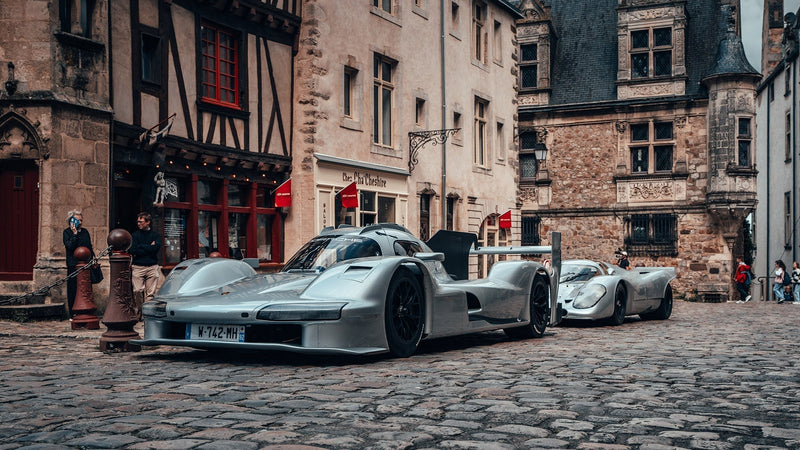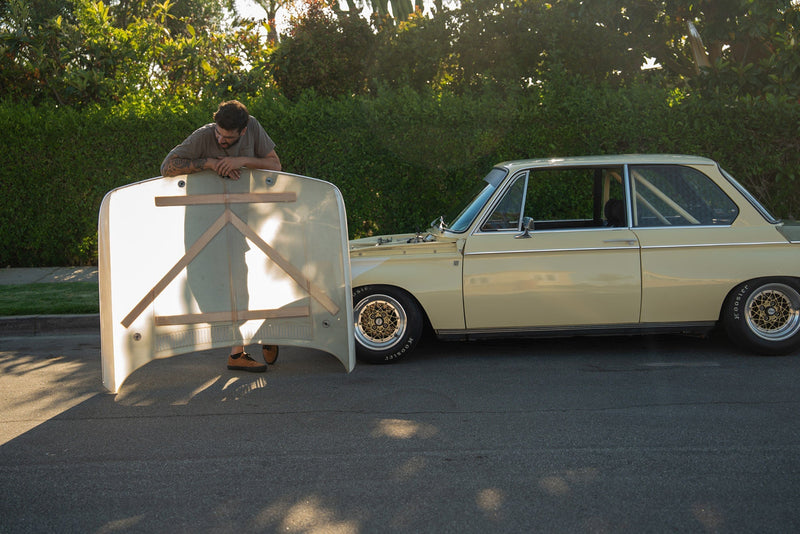American-made land yachts of yesteryear have found second homes amongst lowriders and doo-wop enthusiasts, long-wheelbase JDM four-doors have enjoyed a dedicated fanbase in the “VIP” scene for decades now, but the most attention that German luxury cars can hope for in their old age is a tired joke or two about despots and their fondness for big Benzes with flag holders. These are generalizations that leave a few niches out, but there are good reasons that explain why you don’t see many 30-year-old Eurobarges getting treated to restorations.



There are some exceptions—a handful of rarities from Alpina, AMG, Audi Sport, and the higher-end of the aftermarket “1000SEL” crowd—but most flagship German luxury cars perform about as well as underwear in the secondhand market, which results in (many literal) tons of tired S-Classes, 7-Series, A8s, and the like waiting to be plucked from your local Billy Bob’s Discount European Auto Source for pennies on what was once top dollar.
In the economy of the used car lot, faded silver Civics command more cash than leather-swaddled Autobahn stormers with twice the cylinder count, but considering the Germans’ penchant for Matryoshka-esque styling across model ranges and the fact that keeping up with maintenance thirty years down the road is just as time-consuming and costly as it was when the car was new (or most likely even more so, given warranty expirations), it makes sense that people don’t want the headache of dealing with a used 7-Series when everyone will confuse it with a 5er anyway.





Even if you do find the rare survivor with all the once-indulgent gizmos in working order, it will never claw back its former glory, which is mostly because that former glory rested on it being the most expensive option; a defining trait that rarely ages well. The idea that driving an old luxury car will confer the same status as driving a new one—whether or not said status is worth pursuing is another question—is an illusion reserved for the ballers on a budget dragging around ’03 S-Classes on blown out self-leveling shocks and four mismatched tires. But the wannabe gangsters and Chechen mob wedding convoy fillers aren’t the only ones playing around with old country club toys.
Case in point is my friend Jim and the green 700-horsepower driving machine he built out of an automatic BMW E32-generation 735iL that he bought for $500. The cheap entry fee is about the only typical part of this Teutonic titan’s story, and as Jim tells me, the goal at the start of the build was a turbo motor and 400 horsepower at the rear wheels, not to tell people he was driving “a BMW 7-Series.”

Over the course of the build the target and then the actual number crested the 700-mark (on 104-octane fuel with methanol injection, it registered over 740whp and 790lb-ft), but for the first few years of ownership he simply drove it around like any old car, automatic four-speed and all. With the parts pile rising though, once he got started on the build he made swift work of the transformation.
A specialty mechanic by trade, Jim’s mod list was always going to tilt towards the mechanical elements, but this being an altogether comprehensive build, the aesthetics have been similarly elevated—and as any of us who’ve chased period-correctness can probably attest, the styling changes started with a set of wheels. In this instance it was the classic Speedline Alessio design—a Porsche staple—that was the first choice, but the degree of fender rolling required to fit the low-offset wheels saw a set of 19” BBS LM-Rs take their place, which were soon swapped out for the six-spoke 18” MK Motorsport MK-1s that Jim refinished in a deep bronze color. Keen Bimmer enthusiasts will note that the color of the car itself is also non-standard, but it is within the family: British Racing Green, most commonly associated with the E36 M3 GT.




The headlights are done in the French style, but that’s about it in regards to the visual changes to the exterior—better to keep it simple and highlight the clean body lines with a fresh coat of paint than tack on extra fiberglass anyway. Inside, rather than the gutted mess that defines most interiors of high-horsepower “shop” cars, the mature but striking style of the exterior is carried over thanks to a full OEM saddle tan leather interior swapped in from a European-spec 750iL, and a Momo Indy steering wheel. The usual result of an interior swap is a few new seats and a lot of new rattles and squeaks, but in here you’d be hard pressed to tell this wasn’t how the car left the factory. Everything fits, everything lines up, nothing sags, nothing pinches, and it doesn’t rattle over every pebble. Paired with the green shell, the deep peanut-buttery guts harken back to a time long gone when luxury cars relied on high-end materials and finishes rather than plasticky infotainment packages. But any airs of mild-manners are quickly abandoned once you see the exhaust pipe sticking out of the hood.
On advice from BMW engine tuning luminary Paul Burke, Jim decided to start with an early M30B34 rather than the stock M30B35 (the former’s block having the primary advantages of a forged crankshaft, forged rods, and an existing oil return boss that could be tapped for a turbo, among other details), and the build itself started from the oil pan up. The list of modifications required to reliably churn 700+ horsepower out of a BMW straight-six made in the early 1980s would turn this into a long list of bullet points, but a few of the main areas of interest paint a clear enough picture of the amount of work involved.



The block was line honed, the forged rods were machined and attached to 8.5:1 compression JE Pistons blueprinted by Paul Burke, and the main studs, rod bolts, and head studs are from ARP. Jim then did a mild port of the head before rebuilding it with new valve guides, stems and heavy duty springs; heavy duty rockers from Ireland Engineering with VAC Motorsport rocker locks; and a turbo-optimized camshaft setup from Paul Burke.
The turbocharger is a Holset HX40 Super originally intended for use in a Caterpillar-brand generator that Jim found brand new on eBay, which was then machined to fit a 64mm Garret compressor. The turbo exhaust manifold is a six-into-one design from iNK, and the intake side of the setup features custom piping, a Tial 44mm wastegate, and most importantly, methanol injection from AEM with a five-gallon supply routed in from the trunk. The management is handled by a Megasquirt system that Jim fine-tuned for this build.



To complete the powertrain, the stock automatic transmission was swapped out for a five-speed Getrag 260, but when it couldn’t handle the torque a Getrag 265 sourced from an E30 M3 took over. It was paired up with a bell housing from an E28 533i, but to get the power all the way down the extended wheelbase of the iL chassis required some custom work on the driveshaft. John Volk (known for his Tesla-powered E30, among other out-there builds) modified the front and rear sections of the driveshaft to fit the Getrag 265 in the front and the 3.15 LSD in the back (the latter sourced from an E32 750).





Since Jim’s intention was never to make something that was good at burnouts but not much else, the chassis was also upgraded in kind. Polyurethane bushings from AKG replaced the stock rubber, and in place of the stock self-leveling dampers, BC Racing coilovers for an E34 M5 were were fitted with uprated Swift springs to handle the extra weight of the 7-Series application. Tapping his knowledge and parts supply, Jim also retrofitted front lower control arms from an E31 850CSi to take advantage of their spherical bushings, added a Brembo-made four-piston Dinan brake kit to the front end around floating rotors, and vented E32 740 brakes in the rear. The last material change to the platform was an E34 M5-sourced steering box. Not having built this car nor having the ability to, I am surely leaving out more than few things that turned this former cruise ship into a cruise missile.
In other words, this car was “gone through,” and going for a ride confirmed that it was done without shortcuts. It seems like the fate of any talented builder and a turbo project is inevitably some wastegate-whistling mess of a car that has all the horsepower in the world but no viable way to enjoy any of it beyond a traction-free demonstration of the limitations of tire rubber. To be clear, this thing is an efficient smoke machine if need be, but with a variety of selectable tunes on hand, it can still be enjoyed as a genuinely fast car and not a chest-pounding display of unusable power. This car is as far from a gimmick as it gets, but it certainly is a novelty. When's the last time you've seen an E32 on the road? Let alone one packing more power than a modern Lambo?






















































